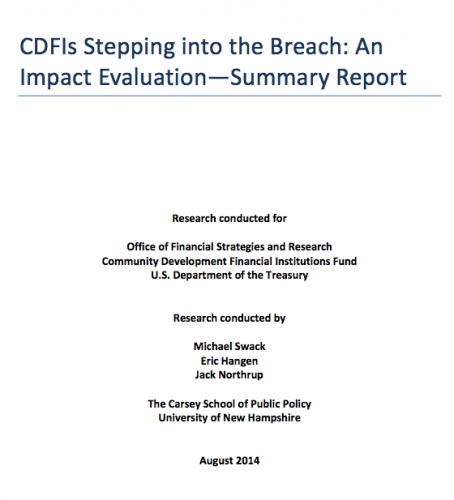This report summarizes research undertaken by the Carsey School of Public Policy to evaluate impacts of the Community Development Financial Institutions (CDFI) Fund on CDFIs and of the CDFI industry on the people and communities it serves.
Some of the key findings of this research indicate that CDFIs are advancing the statutory purposes of the CDFI Fund to promote economic revitalization and community development through the provision of credit, capital and financial services to underserved populations and communities in the United States. More specifically, the main findings are that:
- CDFIs are using a broad range of metrics to track success across a very broad range of outcomes. The diversity of missions that different CDFIs are pursuing presents one of the principal challenges to developing shared impact measurement systems, including the Community Investment Impact System (CIIS) used by the CDFI Fund. Nevertheless, we see a number of promising evaluation initiatives underway in the field. These range from rigorous evaluation work undertaken by leading CDFIs to efforts to develop impact measurement systems and proxy measures that could pave the way to broader engagement in meaningful evaluation activity across the field.
- The CDFI industry has grown substantially, leveraging investment and increasing its lending activity even in the face of a recession and cataclysmic changes in the financial environment. CDFIs have grown their lending volume far in excess of what would be expected if they depended solely on CDFI Fund financial awards for their capital. However, the CDFI sector remains tiny relative to mainstream financial institutions.
- CDFIs are delivering the majority of their lending to borrowers from targeted, historically underserved groups such as low-income or minority borrowers. Depending on loan purpose, CDFIs are delivering from roughly 65 to over 90 percent of loan volume to historically underserved borrowers. These borrowers include low-income households and business owners, minorities, unbanked borrowers, first-time homebuyers, nonprofit or tribal organizations, female-headed households, or borrowers living in a CDFI Fund designated Investment Area.
- CDFIs are concentrating lending activity in census tracts with signs of distress such as high-poverty or unemployment rates—much more so than conventional lenders. This evidence suggests that CDFIs do indeed “fill the gap” that is left by conventional lenders. However, the results from a multivariate analysis of whether tracts with lower levels of mainstream lending are more likely to receive CDFI loans than other tracts that are distressed in other ways are inconclusive—although data and methodological limitations may be largely responsible for this result.
- CDFIs are meeting needs for financing with “plain vanilla” products that minimize risks to the borrower. Most financing offered by CDFIs is on terms that decrease borrower risks—for example, most financing is offered on a fixed rate, and balloon payments are rarely a feature of CDFI loans outside the real estate development sector, where such features are to be expected. However, many CDFIs appear to struggle to meet market needs for longer-term loans, a dynamic that may relate to the lack of access to longterm capital in the sector.
Download CDFIs Stepping into the Breach
Table of Contents
| Study Overview | |
| The State of Impact Measurement in the CDFI Industry | |
| Measuring Impact of CDFIs | |
| Development of Impact Measurement Tools for the Industry | |
| GIIN and the IRIS Metrics | |
| Moody’s Analytics—Social Performance Assessment to Assess How Well a Microfinance Institution Achieves Social Goals | |
| Aspen MicroTracker | |
| Success Measures | |
| Analysis of CDFI Lending Activity | |
| Methodology and Limitations | |
| Finding 1: The CDFI industry has grown substantially, leveraging investment and growing its lending activity even in the face of a recession and dramatic changes in the financial environment. It remains, however, a tiny sector relative to mainstream financial institutions | |
| Finding 2: CDFIs are delivering the majority of their lending to borrowers from targeted, historically underserved groups such as low-income or minority borrowers | |
| Finding 3: CDFIs are concentrating lending activity in census tracts with signs of distress such as high poverty or unemployment rates—much more so than conventional lenders | |
| Finding 4: CDFIs are meeting needs for financing with “plain vanilla” products that minimize risks to the borrower. However, they struggle to meet market needs for longer-term loans | |
| Finding 5: There is little evidence of a spatial-temporal relationship between CDFI lending and mainstream lending activity, although data limitations impact this analysis | |
| Finding 6: No relationship between concentrated and sustained CDFI lending activity was detected in a particular census tract and subsequent improvement of neighborhood conditions in that census tract. However, data and methodology limitations again are very likely impacting the analysis | |
| Impact of CDFI Fund Awards on CDFI Financial Health and Activity Levels | |
| Regression Discontinuity Analysis | |
| A Note on Debt Versus Equity Financing | |
| Key Themes and Findings from Interviews and Focus Groups | |
| Recommendations for Future Evaluation Efforts | |
| Focus Additional Research on the Most Effective Strategies to Support Growth of the CDFI Industry | |
| Standardize Definitions | |
| Develop Shared Measurement Systems, Including Encouraging Fuller Use of the | |
| Fund’s Impact Reporting System | |
| Develop Proxy Measures | |
| Carry Out Regular External Evaluations | |
| Final Recommendation—A CDFI “Infrastructure and Innovation” Fund | |
Format
Source





